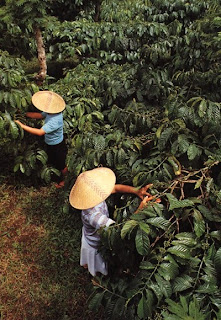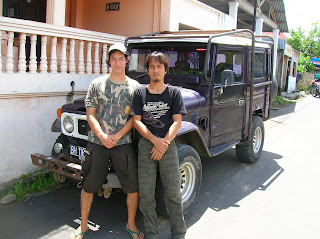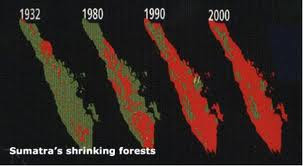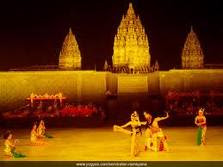Wet rice is an important crop in the valley, but it doesn't grow on hillsides unless extensive systems of terraces are created (1). Here in Kerinci Valley there aren't many terraces, so people grow other crops on the hills. One is dry rice, which is a good crop, but the yield is not nearly as
Another important tree crop is rubber. Did you know that all the rubber in tires and shoes originates from a tree (Hevea brasiliensis)? The trees have to be "tapped", like maple syrup
 trees. The farmer or "tapper" cuts a slice in the tree with his knife, and the tree "bleeds" the raw material for rubber. You can see the process in the picture to the left. Usually a container of some sort is attached to the tree to collect the material. Rubber originated in South America, but was brought to Southeast Asia in the 1800s. When a virus devasted the South American trees, Southeast Asia became the world's leading producer of rubber. Sumatra is still one of the largest producers of rubber in the world. After these trees are planted they started producing rubber in 5-7 years. Rubber trees often supplement other crops planted by farmers here. This is because the price of cash crops like rubber fluctuates; sometimes is high, and sometimes it's low. When it's too low it's not worth the work to harvest the rubber, and so the trees can be left until the price increases again.
trees. The farmer or "tapper" cuts a slice in the tree with his knife, and the tree "bleeds" the raw material for rubber. You can see the process in the picture to the left. Usually a container of some sort is attached to the tree to collect the material. Rubber originated in South America, but was brought to Southeast Asia in the 1800s. When a virus devasted the South American trees, Southeast Asia became the world's leading producer of rubber. Sumatra is still one of the largest producers of rubber in the world. After these trees are planted they started producing rubber in 5-7 years. Rubber trees often supplement other crops planted by farmers here. This is because the price of cash crops like rubber fluctuates; sometimes is high, and sometimes it's low. When it's too low it's not worth the work to harvest the rubber, and so the trees can be left until the price increases again.Yet another important cash crop here is shown in the picture to the right.
 Can you tell what this is? I'll give you a hint...it's grown on the Big Island as well. That's right, it's coffee. The coffee that adults drink is made from the bean of these bushes. Sumatran coffee is Coffea robusta, a hearty type of coffee that grows well in the climate here. Sumatran coffee is quite famous and is sold all over the world. But it is another type of commodity that is vulnerable to price fluctuations. Sometimes the price is very high, which is good for the farmers, but sometimes the price is very low, and this causes big problems for the farmers (2). So as you can see, the economy of this part of Sumatra is very dependent on cash crops. Can you think of why this might be bad for the economy? What happens if the price for all of these commodities is low at the same time? In those cases, everybody suffers. In addition, there is really only one way to make more money off of these crops: to grow more of them. That means expanding the area in which these crops are grown. And I've told you in other posts what this can lead to.
Can you tell what this is? I'll give you a hint...it's grown on the Big Island as well. That's right, it's coffee. The coffee that adults drink is made from the bean of these bushes. Sumatran coffee is Coffea robusta, a hearty type of coffee that grows well in the climate here. Sumatran coffee is quite famous and is sold all over the world. But it is another type of commodity that is vulnerable to price fluctuations. Sometimes the price is very high, which is good for the farmers, but sometimes the price is very low, and this causes big problems for the farmers (2). So as you can see, the economy of this part of Sumatra is very dependent on cash crops. Can you think of why this might be bad for the economy? What happens if the price for all of these commodities is low at the same time? In those cases, everybody suffers. In addition, there is really only one way to make more money off of these crops: to grow more of them. That means expanding the area in which these crops are grown. And I've told you in other posts what this can lead to.There is one other crop that is extremely important to this particular part of Sumatra: tea. Tea is generally grown on plantations, though, because you need
So you can see how important agriculture is to this area. This is what the people here do, and it's what they have done for generations. It's also what their children will do. That's all for today. Why don't you think about the questions I've included below?
1. "Terraces" are used to grow wet rice on hills. The farmers cut into the mountains to make flat spaces where the rice can grow. This alters the landscape significantly, but terraces are wonderfully beautiful in some places. See if you can find some pictures on the internet. Start with "Banaue" in the Philippines. What did you find out? Where else do they have rice terraces? What other crops are grown on terraces? Check out "Machu Picchu".
2. What sorts of factors might cause the price of a commodity to go up? What might cause the price to go down?





























